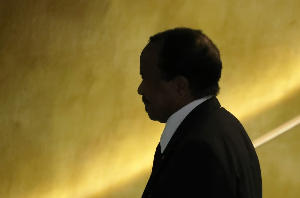Opinions of Wednesday, 12 November 2014
Auteur: Cameron duodu
Ebola: Have we uncovered 'the smoking gun?'
I have tried to be fair to the United States Government whilst writing about the Ebola outbreak in Guinea, Sierra Leone and Liberia.
I applauded President Barack Obama
when he invited to the White House and openly hugged a nurse who had been suspected of having caught the virus, but had subsequently been cleared of infection by the disease.
And I also congratulated Obama on having had the guts to dispatch his UN Ambassador, Samantha Power, to the three stricken countries,
especially at a time when Obama's opponents were hysterically imposing quarantines on everyone in the States they governed, who had come near, or was suspected of having the slightest possible connection, with the disease.
President Obama also sent troops to Liberia to construct and man health units that can be used for treating Ebola victims.
All that is extremely courageous, given the testy atmosphere in which he was operating at the time, with Republican politicians looking for every excuse to damn him, so that they could win the elections that were pending at the time.
Despite these admirable postures, the US Government has resolutely refused to make any comments on perfectly legitimate questions that I and other African commentators have asked, namely whether the US Government considers it possible that the outbreak of Ebola in the three neighbouring countries in West Africa's Mano River Region, had anything to do with research work that certain American institutions, including Tulane University of New Orleans, Louisiana, USA, had been carrying out there for the past seven years (at least).
Indirectly, however, the US Government has now admitted that those of us who have genuine questions to ask about the research work that was being done in the three countries are not just ‘conspiracy theorists’ like some of those who proliferate the Internet, and whose exaggerated claims sometimes make it difficult for a calm, informed and rational debate to take place on Ebola.
The indirect US admission that it may know something which it is not saying, about the origins of the Ebola outbreak in West Africa came in the form of a White House statement that was published in the New York Times on 17 October 2014.
(Amazingly, despite the hysterical reporting in the American media of anything concerning Ebola, the White House statement appeared to have ''escaped the notice" of many of the media that have been cranking up fear over Ebola in the US for several months now! With the glorious exception of the venerable New York Times!)
The New York Times report read:
QUOTE: White House to Cut Funding for Risky Biological Study
By DONALD G. McNEIL Jr. OCT. 17, 2014
Prompted by controversy over dangerous research and recent laboratory accidents,[emphasis added] the White House announced Friday [17 October 2014] that it would temporarily halt all new funding for experiments that seek to study certain infectious agents by making them more dangerous.[emphasis added].
[The White House] also encouraged scientists involved in such research on the influenza, SARS and MERS viruses to voluntarily pause their work while its risks were reassessed.
(Note that there was no mention of haemorrhagic fevers, including Ebola and Lassa, in the White House statement,although work on these diseases fall unquestionably into the category of 'dangerous' research!)
Opponents of this type of research, called gain of function [emphasis added] — for example, attempts to create a more contagious version of the lethal H5N1 avian influenza to learn which mutations made it that way — were elated.
“Brilliant!” said Peter Hale, the executive director of the Foundation for Vaccine Research, which opposes such experiments.
“The government has finally seen the light. This is what we have all been waiting for and campaigning for. I shall sleep better tonight.”
In June [2014] workers at labs at the Centres for Disease Control and prevention may have been exposed to anthrax.
In June [2014] workers at labs at the Centres for Disease Control and Prevention may have been exposed to anthrax.
The announcement, which was made by the White House Office of Science and Technology Policy and the Department of Health and Human Services, did not say how long the moratorium would last. It said a “deliberative process to assess the potential risks and benefits” would begin this month [October 2014] and stretch at least into next year [2015].
The move appeared to be a sudden change of heart by the Obama administration, which last month [September 2014, that is, eight months after the outbreak of Ebola in West Africa] issued regulations calling for more stringent federal over sight of such research and requiring scientists and universities to disclose that their work might be risky, rather than expecting federal agencies to notice. [emphasis added].
Critics at the time dismissed those rules as too weak.[emphasis added] The moratorium is only on research on influenza virus and the corona viruses that cause SARS and MERS. It made no mention of Ebola or any related filovirus. Ebola is already extremely lethal, but it is not easily transmissible.
[Says who?]
No scientist has publicly announced [emphasis added] an attempt to make Ebola as easy to transmit with a sneeze as flu is. Given the current panic around Ebola, and congressional anger at federal health agencies, it is unlikely that federal funding for such a project would be given out. [To which I respond: Oh yeah? Didn't the funding start long before “the current panic around Ebola” broke out? Is the venerable NYT speaking with a forked tongue or what?]
The debate over the wisdom of “gain of function” research erupted in 2011 when the labs of Ron Fouchier of Erasmus University in the Netherlands, and Yoshihiro Kawaoka of the University of Wisconsin-Madison,[USA] separately announced that they had succeeded in making the lethal H5N1 avian flu easily transmissible between ferrets, which are a model for human susceptibility to flu.[emphasis added].
The debate heated up further this year [2014] when the [US] Centres for Disease Control and Prevention admitted it had suffered laboratory accidents that exposed dozens of workers to anthrax, and [had also]
shipped deadly avian flu virus to another federal lab that had asked for a more benign flu strain. Also this year,[2014] vials of smallpox that had been forgotten for 50 years were found in a lab at the National Institutes of Health. [Mama mia! Smallpox was “eradicated” from the world decades ago, so what were the vials being kept for? To be used in re-introducing smallpox into populations whose governments the US considered ''hostile”? Lord help us!]
The White House said the moratorium decision had been made “following recent bio-safety incidents at federal research facilities.”[emphasis added. I ask: Do ''Federal research facilities” include those that were being operated for the Pentagon and other US agencies by Tulane University in New Orleans, Louisiana, USA, and other American research bodies in Sierra Leone, Liberia and Guinea, in the Mano River region?]
Dr Kawaoka [mentioned above] said he would not start any new gain-of-function experiments and would consult with the N.I.H. about which ones he had under way that met their criteria for the moratorium.
Many scientists were furious that such work had been permitted and even supported with American tax dollars. [emphasis added]
But others argued that it was necessary to learn which genetic mutations make viruses more dangerous. If those mutations began appearing naturally as the viruses circulated in animals and people, warnings could be issued and vaccines designed, they said.
Some scientists argued that the two scientists should not be permitted to publish all the details of their experiments, for fear that terrorists or unscrupulous scientists
would duplicate them and start a fatal pandemic.
[There are no “terrorists and unscrupulous scientists” in the US, of course?! No – those who might copy the experiments could be terrorists or unscrupulous scientists, but not those who conceived of and carried out the experiments of their own volition in the first place, right? Oh – okay, some American scientists did infect poor African-American share-croppers in Tuskegee (USA) with syphillis, but they were not exactly “unscrupulous” were they? After all, they were Americans! (Not Russians or North Koreans or Arabs! Anyway, that was a long time ago, wasn't it?]
Other [scientists], like Richard H. Ebright, a molecular biologist and bio-weapons expert at Rutgers University (USA) , argued that the long history of accidental releases of infectious agents from research labs made such work extremely risky and unwise to perform in the first place.
[It was precisely such “extremely risky” work that was being done at Kenema and other sites in Sierra Leone, among other places in West Africa!]
Dr Ebright called Friday’s announcement “an important, albeit overdue, step.” Michael T. Osterholm, director of the US Centre for Infectious Disease Research and Policy at the University of Minnesota, called the moratorium “a wise move — I congratulate the U.S. government on taking this step.”
END QUOTES FROM THE NEW YORK TIMES.
Meanwhile, another American newspaper,USA Today, has reported: QUOTE: New lab incidents fuel fear, safety concerns in Congress By Alison Young USA TODAY 10:54 a.m. EDT September 23,2014
Scientists wearing space-suit-like protective gear searched for hours in May [2014] for a mouse — infected with a virus similar to Ebola —[EMPHASIS ADDED] that had escaped inside Rocky Mountain Laboratories in Montana, one of
the federal government's highest-security research facilities, according to newly obtained incident reports that provide a window into the secretive world of bio-terror lab accidents.
During the same month, at St Jude Children's Research Hospital in Memphis, a lab worker suffered a cut while trying to round up escaped ferrets that had been infected with a deadly strain of avian influenza, records show.
Four days later, at Colorado State University's bio-terrorism lab, a worker failed to ensure [that] dangerous bacteria had been killed before shipping specimens — some of them still able to grow — to another lab, where a worker unwittingly handled them without key protective gear. [EMPHASIS ADDED]
Nobody was sickened in the incidents and the mouse was caught the next day. Yet in the wake of serious lab mishaps with anthrax and bird flu at the Centres for Disease Control and Prevention that prompted an uproar and a Congressional hearing this
summer, these additional incidents are further fuelling bipartisan concern about lab safety.
"As long as we keep having an ad hoc system of oversight in this country, we're going to keep seeing more and more incidents," said U.S. Rep Diana DeGette of Colorado, the ranking Democrat on the House oversight subcommittee that held the hearing in July [2014].
Added subcommittee Chairman Tim Murphy, R-Pa.: "These incidents underscore why the committee has been investigating the safety of high-containment labs."
The CDC and the U.S. Department of Agriculture jointly run the Federal Select Agent Program that oversees government, university and private laboratories working with dangerous viruses, bacteria and toxins called "select agents", because they're deemed to pose serious threats to people and agriculture and could potentially be used as bio-weapons.
Most of these facilities are "high-containment" laboratories operating at bio-safety levels 3 and 4, the highest levels. Each level has increasingly sophisticated safety equipment and protocols to protect researchers from infection and keep deadly pathogens from being released.
The Government Accountability Office,which is the investigative arm of Congress, has warned for years that no single federal entity is responsible for oversight of high-containment labs and there are no national standards for their design or operation. [EMPHASIS ADDED]
It isn't even known how many high-containment labs are in operation nationwide [or overseas?] because those working with dangerous pathogens that are NOT on the federal "select agent" list — such as tuberculosis, MERS-CoV coronavirus and some potentially deadly bird flu strains — are NOT required to register with the CDCUSDA program. Citing bio-terrorism laws, the Federal Select Agent Program doesn't publicly release details about accidents occurring in regulated labs.
More than 1,100 incidents involving select agents were reported by labs from 2008 through 2012 and more than half were serious enough workers received medical evaluation or treatment, USA TODAY reported in [August2014] after obtaining copies of the program's annual reports to Congress. The reports, however, don't name the labs and provide few details beyond tallies of incidents by type. [EMPHASIS ADDED] UNQUOTE
The question, that must be of concern to all those who have Africa's interests at heart is this: if even in hi-tech United States, such incidents can occur, how much more can they not occur in the remote corners of Sierra Leone, Liberia and Guinea – where locally-employed staff, who lack the high qualifications and training of their American research overseers, can be expected to make even worse mistakes than those that led to the escape of the mouse referred to above, or the cuts endured by the American scientists?
In my considered opinion, the American Government owes Africa and the world full disclosure regarding any “events” of a dangerous nature that might have occurred in their facilities in Guinea, Sierra Leone and Liberia, over the past decade or so.
If the US Government doesn't provide this information voluntarily, the African Union, or any member(s) of it, should complain to the United Nations General Assembly about the possibility that the right to good health of the African populations concerned may have been flagrantly flouted.
And they should ask the UN to order an international investigation into what has been going on in the three countries. Just as the UN would almost certainly be asked to do, if American jet fighters were to unleash bombs on them that killed 5,000 people. .. And counting! As Ebola has done, and is continuing to do.














